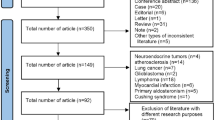Abstract
Purpose
Paraneoplastic syndromes (PNS) are relatively infrequent manifestations appearing before or after a cancer declares itself. Autoimmune mechanisms may be involved, but their cause and pathogenesis are often unknown. Due to disparity of symptoms, PNS remain a major diagnostic challenge. We examined the value of FDG-PET/CT for ruling in or out malignancy in a heterogeneous group of patients with suspected PNS.
Methods
We retrospectively extracted data from all patients referred 2009–2013 with suspected PNS. Data included age, sex, follow-up period, scan report, further diagnostic procedures, and final clinical diagnosis. Conclusions of the scan reports were compared to the final follow-up outcome as determined during an average follow-up of 31 months (range 6–51.5) in patients who were not diagnosed with cancer in immediate continuation of a positive PET/CT scan.
Results
A total of 137 patients were included. Main causes for referral were neurological (n = 67), rheumatological (n = 25), dermatological (n = 18), nephrological (n = 6), haematological (n = 2), abnormal biochemistry (n = 11), and others (n = 8). The cancer prevalence was 8.8 %. The FDG-PET/CT results were as follows: nine true positives, 22 false positives, 103 true negatives, and three false negatives. Corresponding diagnostic values were: sensitivity 75 %, specificity 82 %, accuracy 82 %, and positive and negative predictive values of 29 % and 97 %, respectively.
Conclusion
FDG-PET/CT has in patients with suspected PNS an impressively high negative predictive value and may be of value in ruling out PNS, the more so, the more the number of false positives can be minimized or used in differential diagnosis. We believe that FDG-PET/CT may become an important adjunct to the work-up and triage of patients with suspected PNS.




Similar content being viewed by others
References
Darnell RB, Posner JB. Paraneoplastic syndromes involving the nervous system. N Engl J Med. 2003;349:1543–54.
Titulaer MJ, Soffietti R, Dalmau J, Gilhus NE, Giometto B, Graus F, et al. Screening for tumours in paraneoplastic syndromes: report of an EFNS task force. Eur J Neurol. 2011;18:19–e3.
Dalmau J, Graus F, Rosenblum MK, Posner JB. Anti-Hu--associated paraneoplastic encephalomyelitis/sensory neuronopathy. A clinical study of 71 patients. Medicine (Baltimore). 1992;71:59–72.
Hess S, Blomberg BA, Zhu HJ, Hoilund-Carlsen PF, Alavi A. The pivotal role of FDG-PET/CT in modern medicine. Acad Radiol. 2014;21:232–49.
Hoilund-Carlsen PF, Gerke O, Vilstrup MH, Nielsen AL, Thomassen A, Hess S, et al. PET/CT without capacity limitations: a danish experience from a European perspective. Eur Radiol. 2011;21:1277–85.
Vaidyanathan S, Pennington C, Ng CY, Poon FW, Han S. 18F-FDG PET-CT in the evaluation of paraneoplastic syndromes: experience at a regional oncology centre. Nucl Med Commun. 2012;33:872–80.
Bannas P, Weber C, Derlin T, Lambert J, Leypoldt F, Adam G, et al. 18F-FDG-PET/CT in the diagnosis of paraneoplastic neurological syndromes: a retrospective analysis. Eur Radiol. 2010;20:923–30.
McKeon A, Apiwattanakul M, Lachance DH, Lennon VA, Mandrekar JN, Boeve BF, et al. Positron emission tomography-computed tomography in paraneoplastic neurologic disorders: systematic analysis and review. Arch Neurol. 2010;67:322–9.
Schramm N, Rominger A, Schmidt C, Morelli JN, Schmid-Tannwald C, Meinel FG, et al. Detection of underlying malignancy in patients with paraneoplastic neurological syndromes: comparison of 18F-FDG PET/CT and contrast-enhanced CT. Eur J Nucl Med Mol Imaging. 2013;40:1014–24.
Selva-O'Callaghan A, Grau JM, Gamez-Cenzano C, Vidaller-Palacin A, Martinez-Gomez X, Trallero-Araguas E, et al. Conventional cancer screening versus PET/CT in dermatomyositis/polymyositis. Am J Med. 2010;123:558–62.
Titulaer MJ, Wirtz PW, Willems LN, van Kralingen KW, Smitt PA, Verschuuren JJ. Screening for small-cell lung cancer: a follow-up study of patients with Lambert-Eaton myasthenic syndrome. J Clin Oncol. 2008;26:4276–81.
Ahmad Sarji S. Physiological uptake in FDG PET simulating disease. Biomed Imaging Interv J. 2006;2:e59.
Yamada A, Oguchi K, Fukushima M, Imai Y, Kadoya M. Evaluation of 2-deoxy-2-[18F]fluoro-D-glucose positron emission tomography in gastric carcinoma: relation to histological subtypes, depth of tumor invasion, and glucose transporter-1 expression. Ann Nucl Med. 2006;20:597–604.
Kwee TC, Basu S, Saboury B, Ambrosini V, Torigian DA, Alavi A. A new dimension of FDG-PET interpretation: assessment of tumor biology. Eur J Nucl Med Mol Imaging. 2011;38:1158–70.
Graus F, Delattre JY, Antoine JC, Dalmau J, Giometto B, Grisold W, et al. Recommended diagnostic criteria for paraneoplastic neurological syndromes. J Neurol Neurosurg Psychiatry. 2004;75:1135–40.
Compliance with Ethical Standards
Conflict of interest
The authors declare that they have no conflict of interest.
Informed consent
Approval for patient chart review was obtained from The Danish Health and Medicines Authorities according to Danish legislation on retrospective studies.
Author information
Authors and Affiliations
Corresponding author
Rights and permissions
About this article
Cite this article
Kristensen, S.B., Hess, S., Petersen, H. et al. Clinical value of FDG-PET/CT in suspected paraneoplastic syndromes: a retrospective analysis of 137 patients. Eur J Nucl Med Mol Imaging 42, 2056–2063 (2015). https://doi.org/10.1007/s00259-015-3126-2
Received:
Accepted:
Published:
Issue Date:
DOI: https://doi.org/10.1007/s00259-015-3126-2




